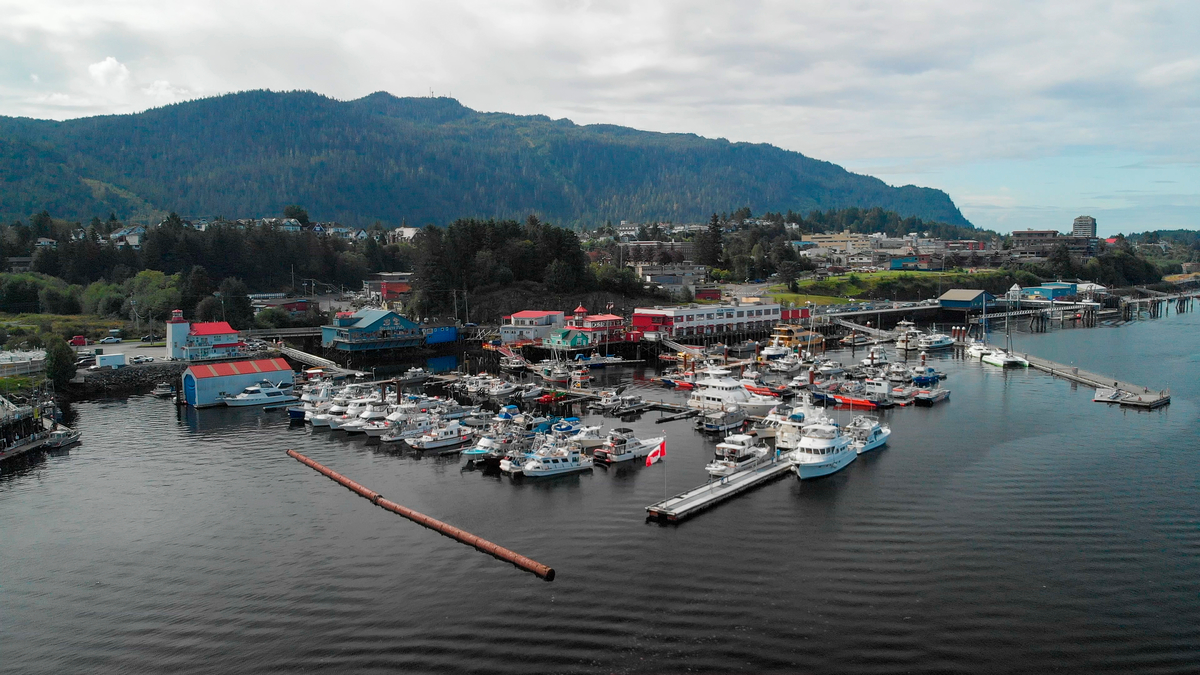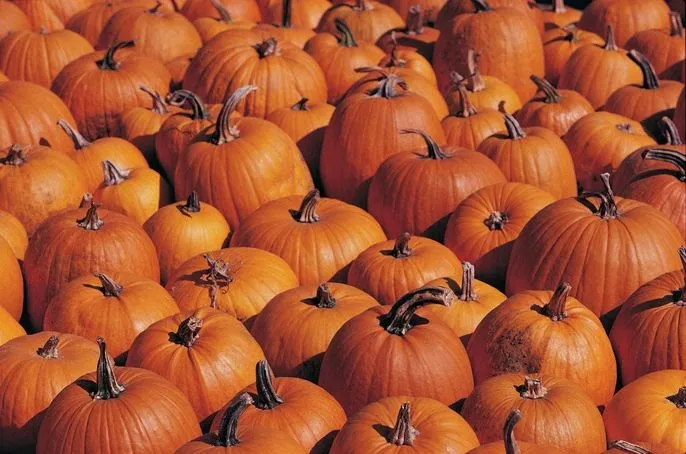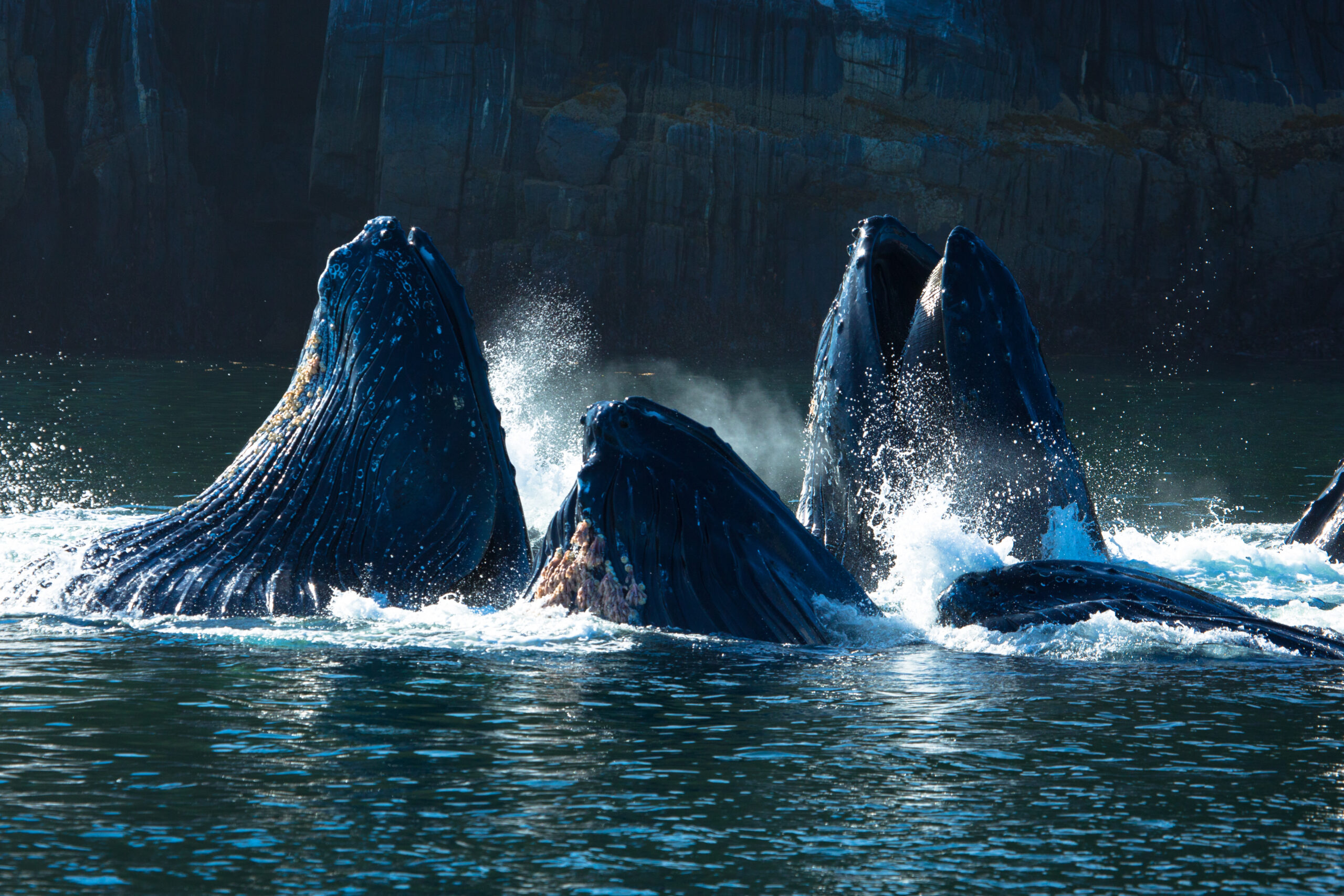The first seasonal harvest in laxyuubm Ts’msyen (Tsimshian territory) is the Eulachon. In Sm’algyax (the language of the Ts’msyen) this time of year is called Ha’lila̱x six’ẅa̱h – the time for harvesting Eulachon; the month of March. In laxyuubm Ts’msyen, we have two major Eulachon runs – the Ksiyeen (river of mist, Skeena River) and the Kluusms (Nass River).
Eulachon are small oily fish that are dense in nutrients. They can be found along the Pacific coast from Alaska to California. Eulachon are also sometimes called candle fish, oolichan, ooligan, hooligan, or saviour fish.
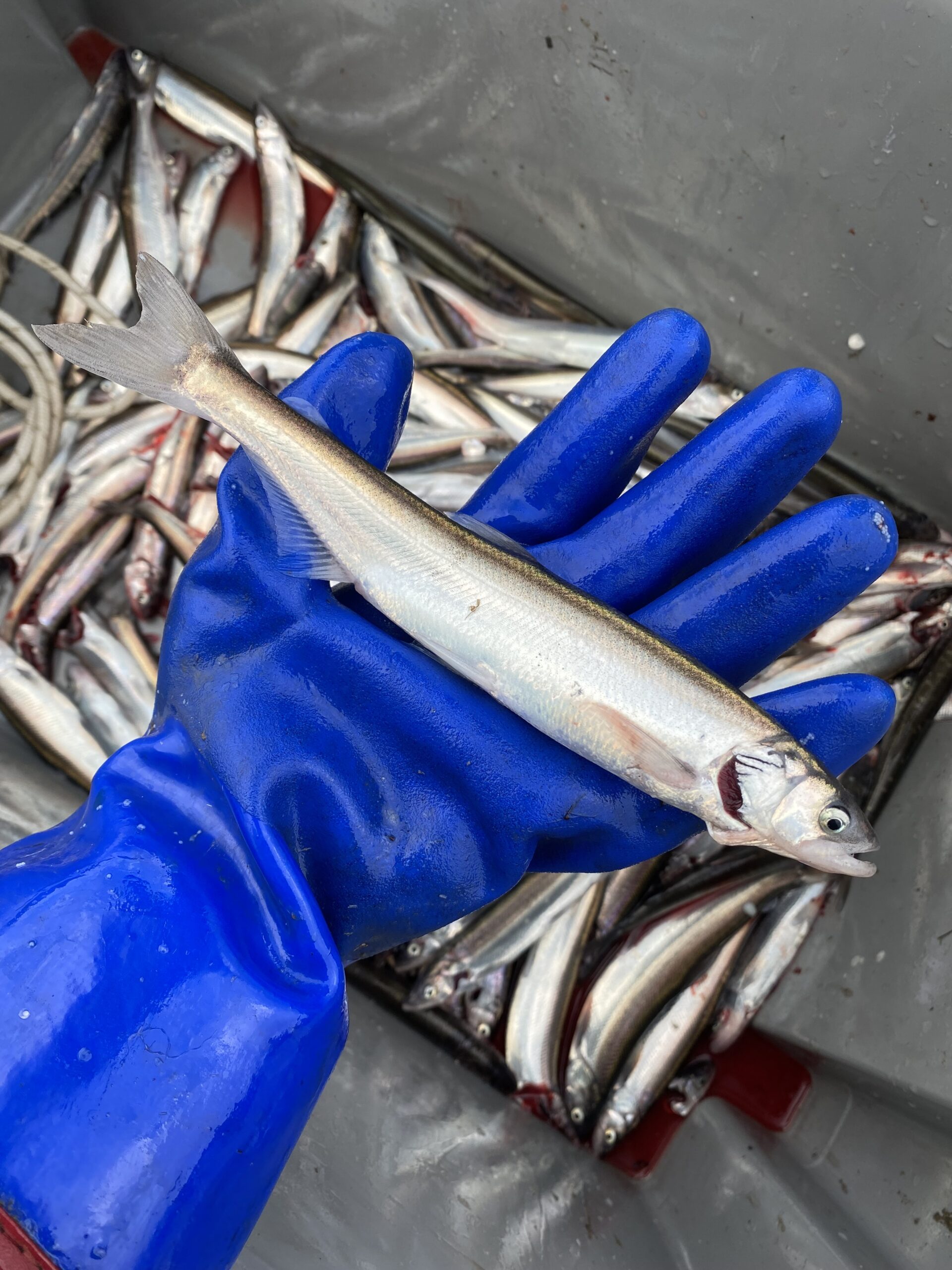
The highly prized Eulachon fish! This one was a stomper. Image by Lisa Girbav
Eulachon are culturally and economically significant for coastal Tsimshian people, as the fish can be processed and eaten in a number of ways (boiled, fried, dried, smoked, frozen, salted etc.). Most famously, these fish are rendered in large vats to make a product called ḵ’awtsii – Eulachon grease. For thousands of years, grease trails were established from coastal to inland communities, which facilitated the harvesting, processing, distribution and sale of Eulachon grease. Today, the Eulachon fishery is a First Nations fishery. Often fishers are working hard to collect their harvest on a given tide.
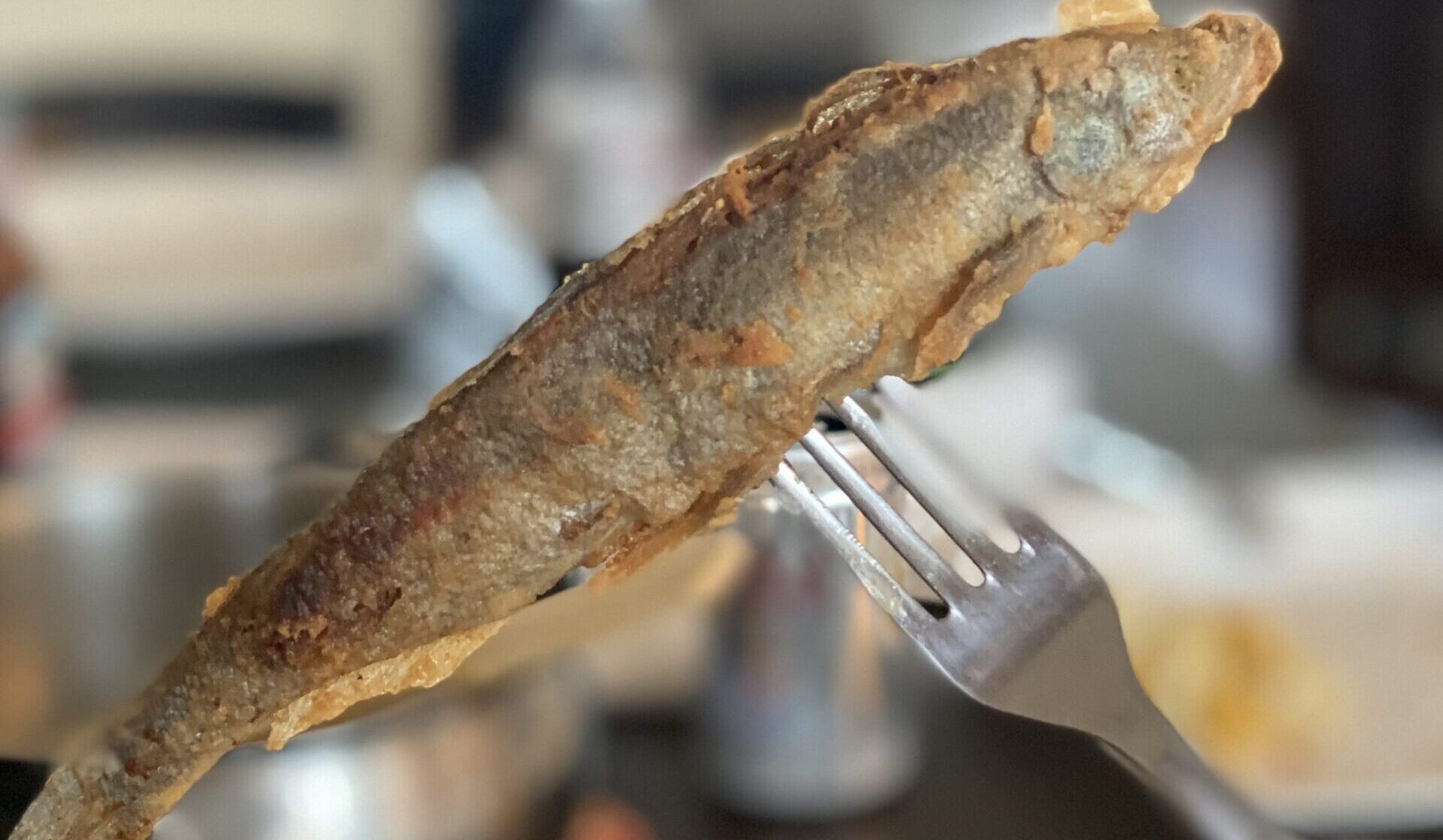
Nothing like mom’s fried Eulachon! Some eat it whole, some gut and debone after it’s cooked. Image by Lisa Girbav
The Eulachon run brings many different users to the Ksiyeen, aside from the regular commercial and recreational traffic along Highway 16. During this time of year, there are First Nations harvesters, wildlife big and small, and visitors who come to see the wildlife and watch fishers collect their harvest. This year we were in conversation with James Russell, who shared his thoughts with Güüdisk on the Skeena Eulachon harvest!
In order to navigate these user groups, visitors should be mindful of their footprint on the Eulachon run and on those who depend on its harvest. Some harvesters may be chatty with visitors interested to learn about the Eulachon run, while others may be more reserved. Ensure you provide space for harvesters to do their work, as the window is relatively short on a given tide to harvest their Eulachon.
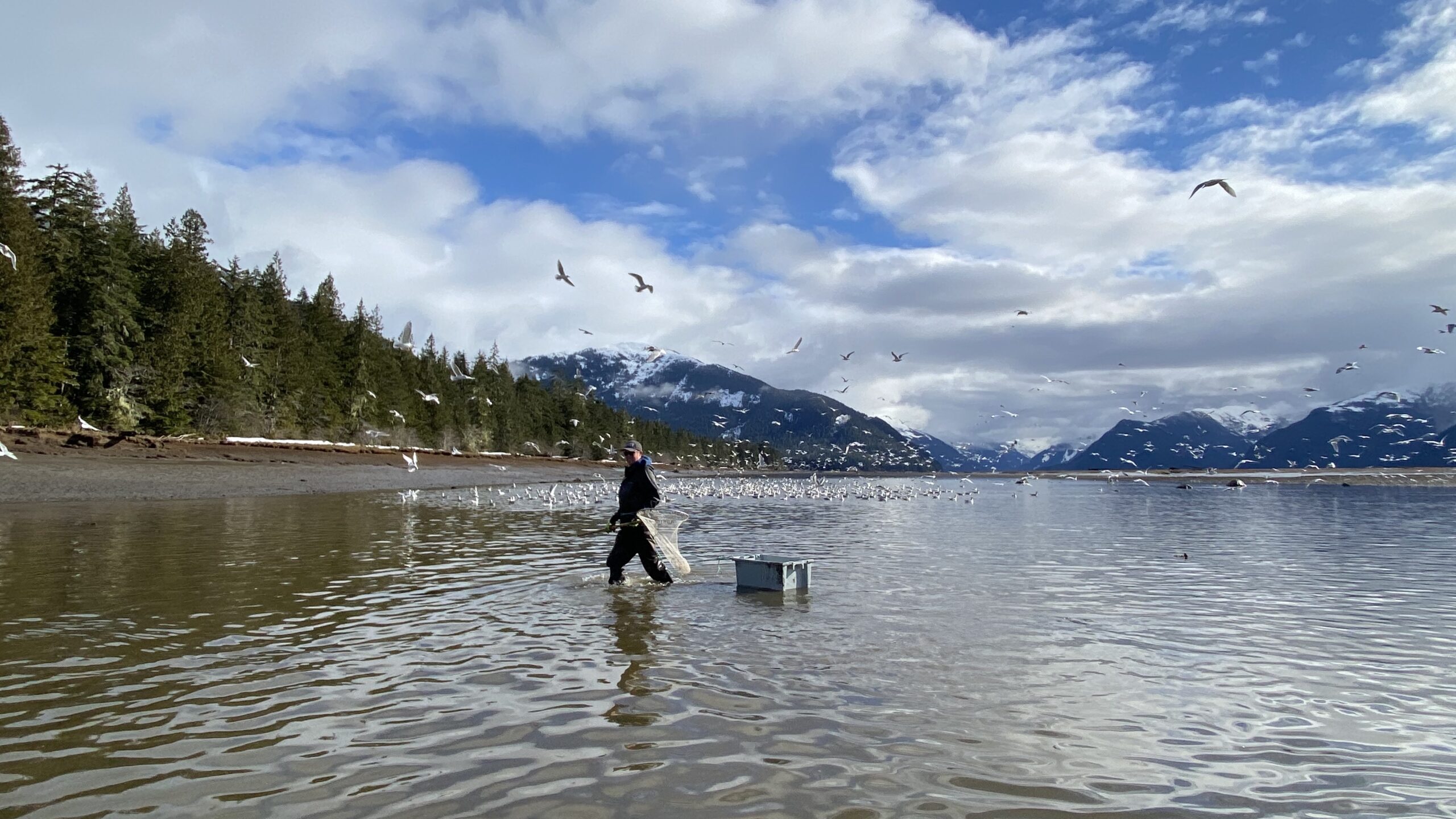
Stephen Kingshott, dipnetting among the seagulls in the Fishing Grounds. Image by Lisa Girbav
Experience the Skeena Eulachon Run
Here are a few things that visitors should consider before visiting the Skeena River this Eulachon season. Before leaving our house, we always check Drive BC for current highway conditions, current weather conditions and the tide tables. Winter driving on Highway 16 can vary this time of year, so we aim for good weather and good driving conditions. Dress for the weather and bundle up. This year, the Skeena was chilly with highs between 2 degrees on the colder days, and 7 degrees (in the sun) on the warmer days. On top of those temperatures, you may also experience a frigid wind chill. It is common to see the snow being blown off the mountain peaks at this time of year. You’ll also want to take your drive during the daytime low tide in the lower Skeena, as this is when the most activity is happening.
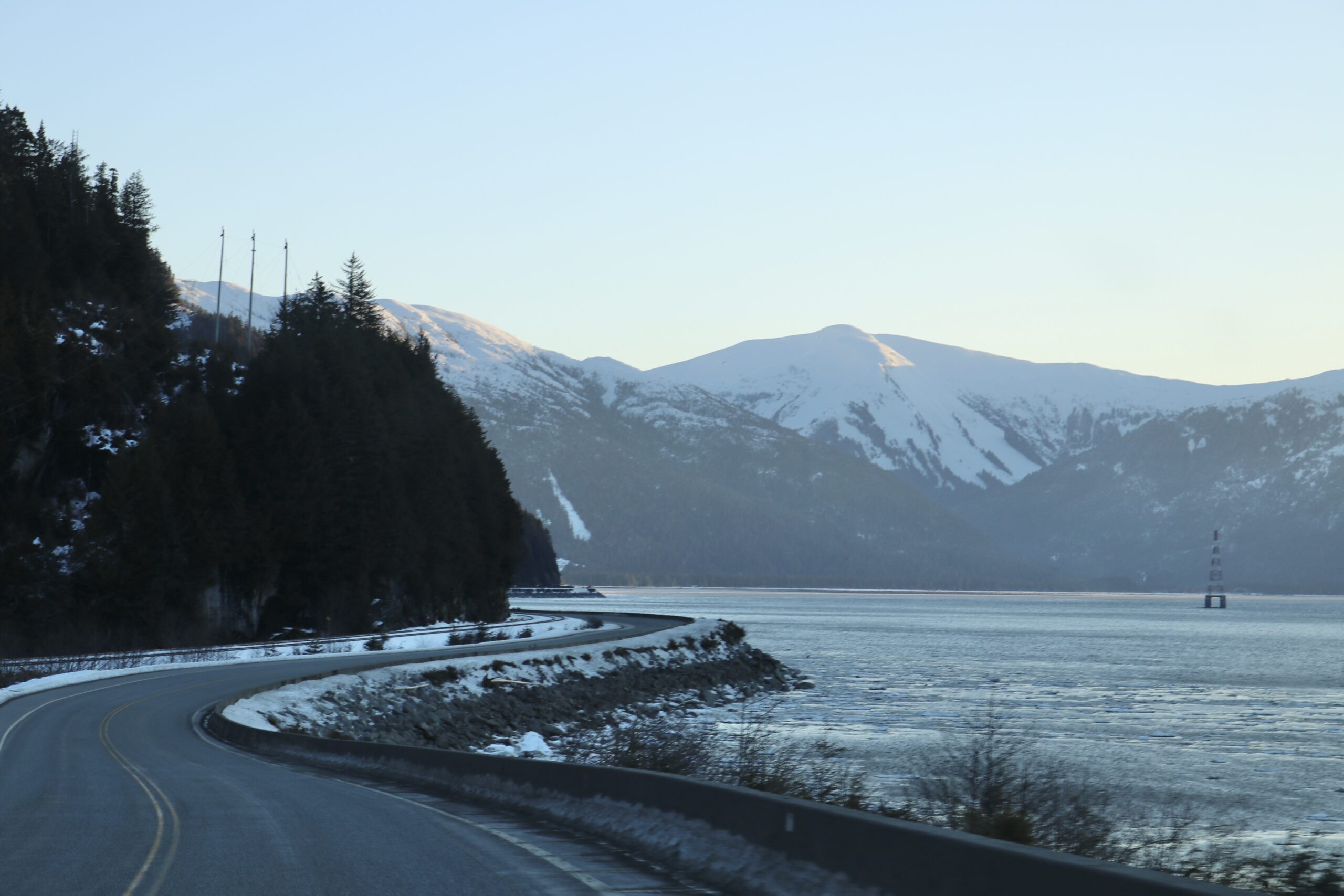
The first view of the Skeena as you drive down from the Tyee Rest Area. Love this view – it never gets old! On this day we had clear roads, but the road conditions can change quickly. Image by Lisa Girbav
Location: Along Highway 16 from Tyee rest stop to Kasiks River
Distance: Between 36.2km-81.4km east of Prince Rupert
Parking: Tyee Rest Stop and Telegraph Point Rest Stop
The Skeena River Eulachon run is visible along Highway 16 between Prince Rupert and Terrace as far up the Skeena as Kasiks River (81.4km east of Prince Rupert). There are two rest points on the highway that offer safe viewing for the Eulachon run, which are the Tyee rest stop (36.2km east of Prince Rupert – 26 minute drive) and the Telegraph Point rest stop (58.4km east of Prince Rupert – 41 minute drive). Highway 16 is a very busy highway, and in the winter the shoulders can be narrow (or non-existent) due to snow. The rest stops provide the most protected area to pull over for viewing the Eulachon run. There is also no gas station between Prince Rupert and Terrace, so be sure to fuel up before you go.
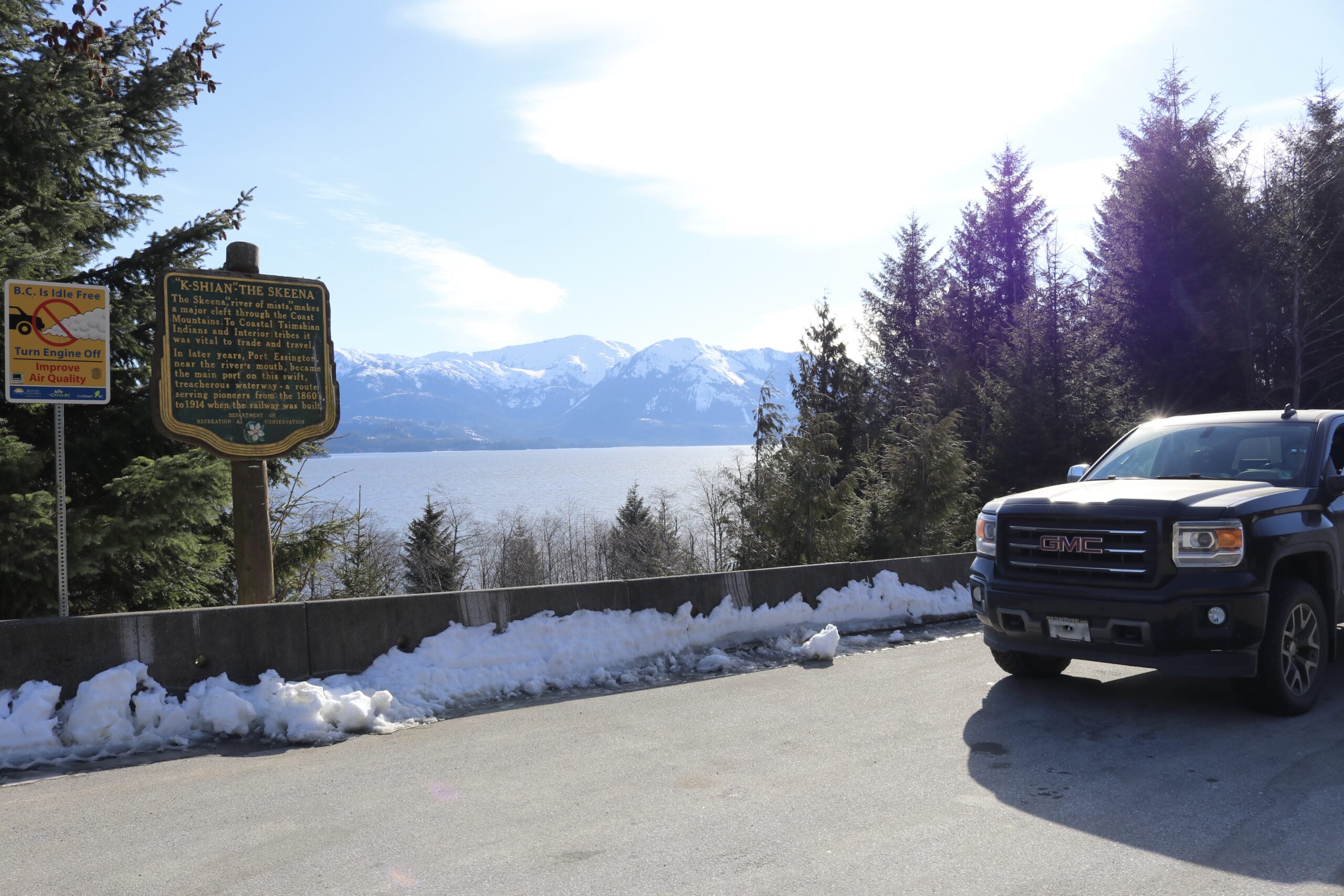
One of the views from the Tyee Rest Area. Image by Lisa Girbav
The Tyee rest stop is the first rest stop as you approach the Skeena from Prince Rupert. It’s a viewpoint at the top of a hill overlooking the Skeena. This rest stop is on the Skeena side of the highway. Unfortunately, there are no restrooms here, but there are restrooms at the next viewpoint – Telegraph Point.
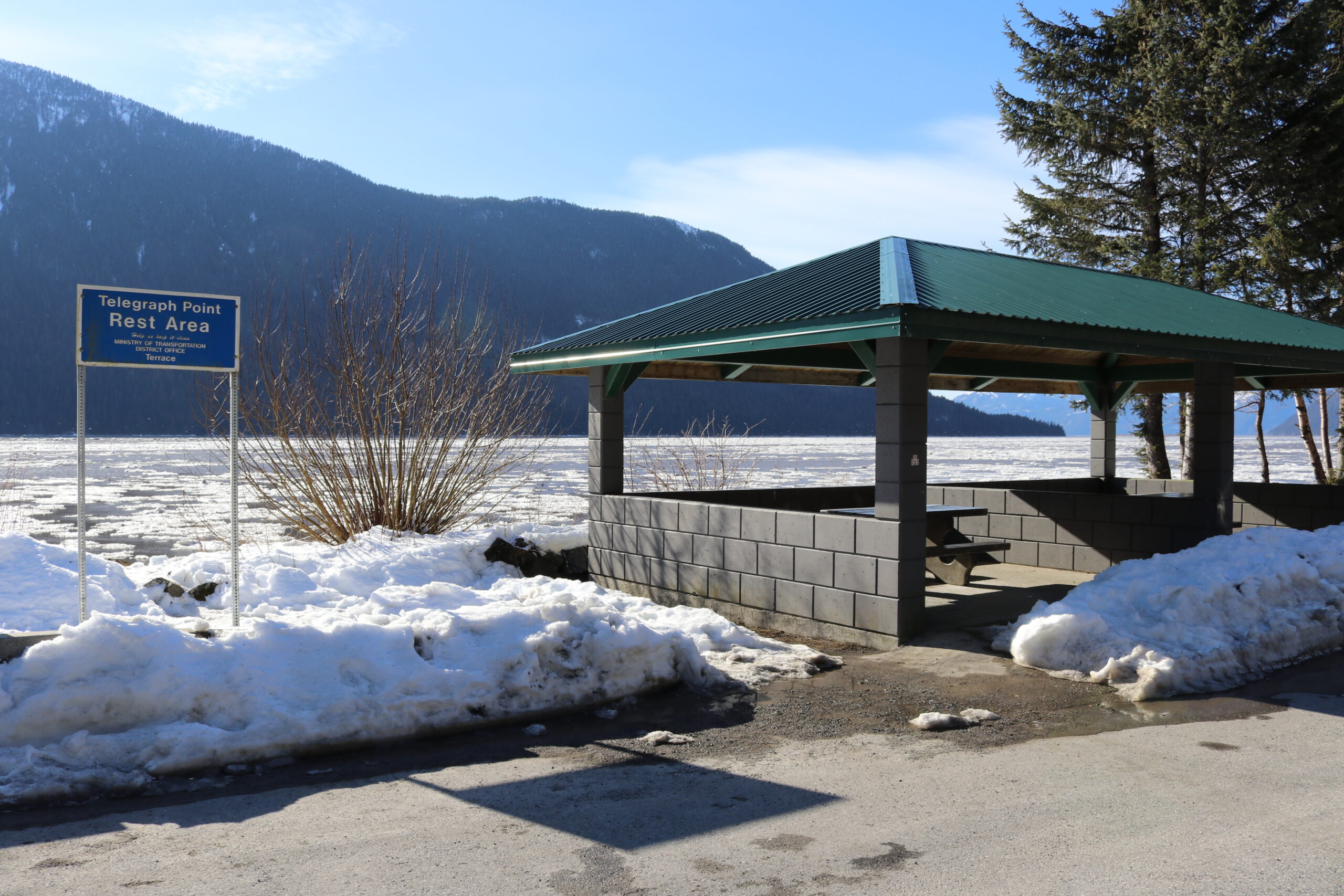
Telegraph Point Rest Area. Image by Lisa Girbav
At Telegraph Point rest stop, you’ll find two rest rooms, and a sheltered viewpoint with picnic benches and garbage bins. At this site, you’ll also find a BC Environment info sign on the Eulachon run. This rest stop offers quite a bit of parking for visitors.
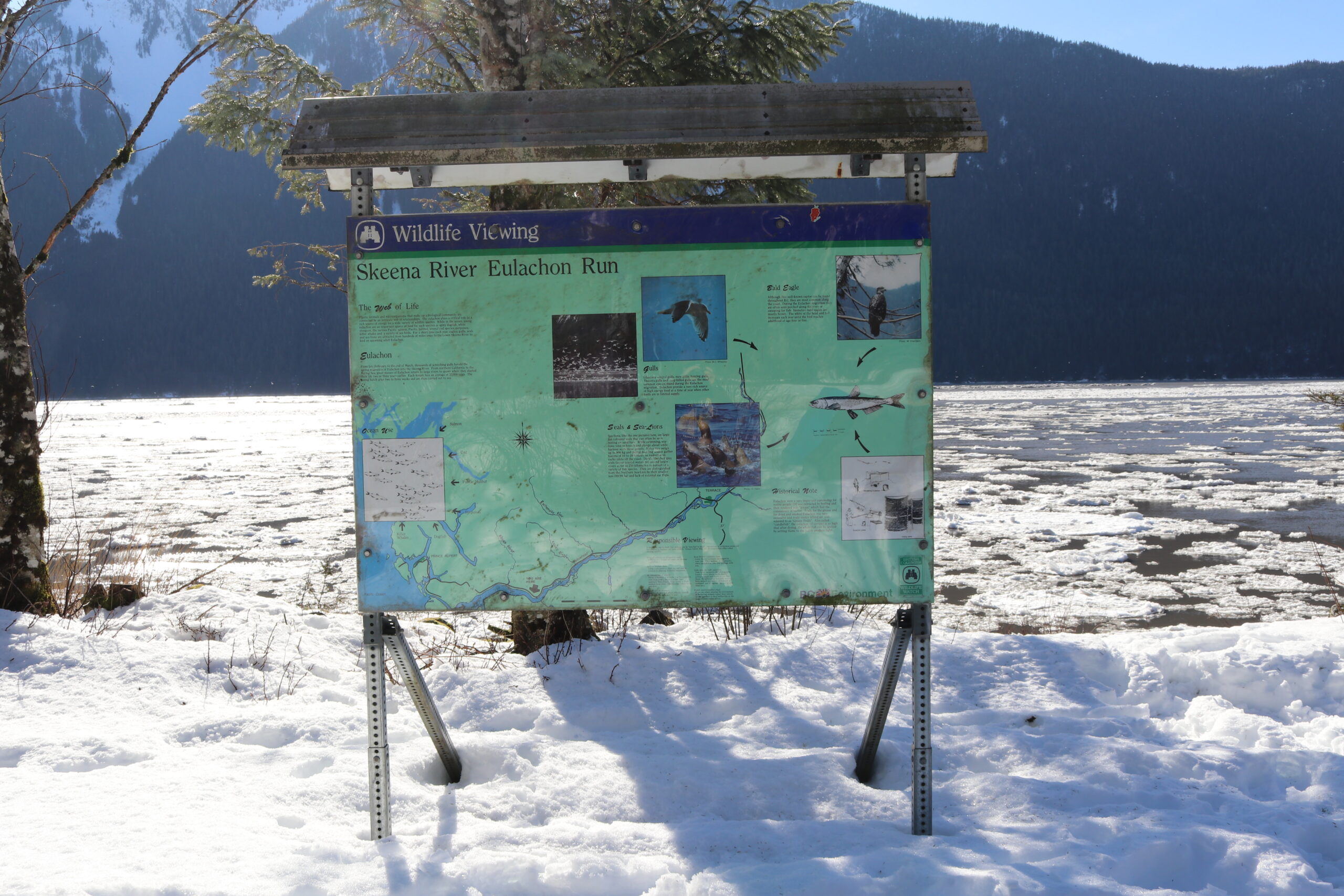
In the background there is ice floating on the river. On this day, we saw the tide pushing the ice against the flow of the Skeena River! Image by Lisa Girbav
I reached out to the Province of BC to request tips on traveling highway 16 this time of year, and here are the resources they provided for traveling safely:
- Check highway conditions on www.DriveBC.ca
- The Eulachon run is near the end of the winter season, so travelers can expect winter driving conditions. Winter Driving and tire information can be found at Winter Driving – Province of British Columbia (gov.bc.ca)
- Avalanche season is still in effect. Information on traveling through an Avalanche Area can be found at Travelling in an Avalanche Area – Province of British Columbia (gov.bc.ca)
- Use pullouts and rest areas to stop safely for viewing sites
- Be observant of your surroundings and other vehicles
When to visit the Skeena for the Eulachon Run
The best time to view the Eulachon run is dependent on the moon and the tides. The run typically lasts a short few weeks between mid February to the end of March. The first run of Eulachon is called Ha’limootk. Ultimately, the Eulachon decide when the Eulachon want to migrate into the Skeena, but the big tides (resulting in low water in the lower Skeena) are what make the Eulachon accessible to harvesters and wildlife alike. The big tides are determined by the lunar cycle, with the biggest tides in line with the new moon.
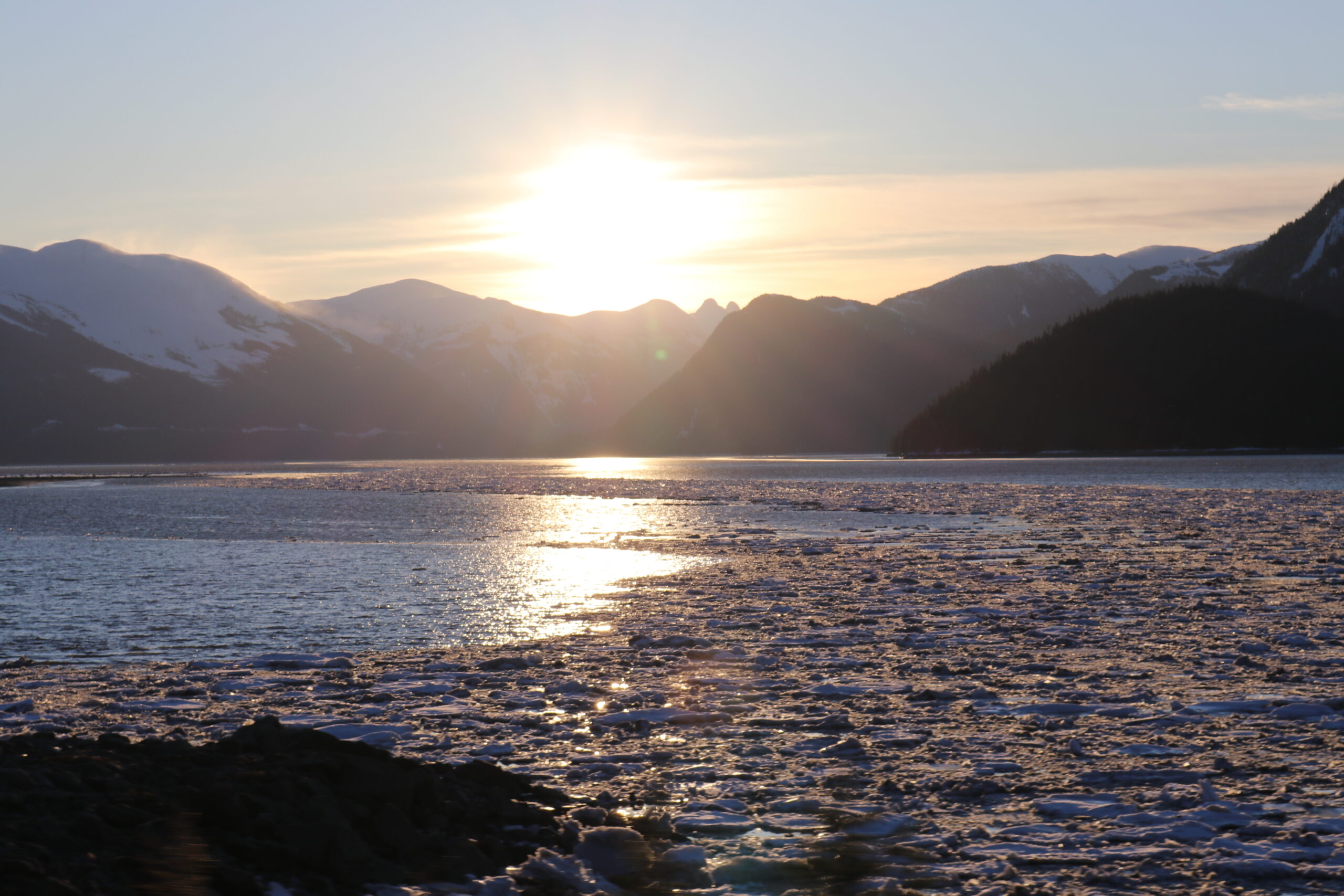
The morning tide on the Skeena. Image by Lisa Girbav
The Skeena River is tidal all the way up to Kasiks. Those little Eulachon fish rely on that tidal movement to push them up against the current of the river. The wildlife activity tends to ramp up during the low tide, where birds and seals and sealions find it easier to hunt for Eulachon. This is also the prime time for First Nations harvesters to obtain their catch. Low tide in the Skeena is typically 2-5 hours after the Prince Rupert book tide (depending on how far up the Skeena you are).
The tides in the Skeena are very dynamic, and can be very deceiving. On the big tides, the tide switches within a very short timeframe. It’s also important to remember that the river is home to the spawning grounds of these fish. Their reproductive cycle can be impacted by excessive foot traffic in their habitat – so it’s best to watch from the safety of the rest stops when possible.
If you’re driving highway 16 at this time of year, please be conscious of the harvesters and visitors who may be parked on or near the highway, and slow down if it is safe to do so.
For those going to view the Eulachon run this year, enjoy and be safe!
Links:
Background Report Eulachon in the North Coast – https://www2.gov.bc.ca/assets/gov/farming-natural-resources-and-industry/natural-resource-use/land-water-use/crown-land/land-use-plans-and-objectives/skeena-region/northcoast-lrmp/eulachon.pdf
Drive BC – https://drivebc.ca/#welcome
GoogleMaps – Tyee Rest Stop – https://www.google.com/maps/place/K-Shian+-The+Skeen/@54.2180216,-130.099205,10z/data=!4m6!3m5!1s0x54732723c198c6db:0x151ae0119729da4f!8m2!3d54.2022259!4d-129.9510526!16s%2Fg%2F11q45jzl7m
GoogleMaps – Telegraph Point Rest Stop – https://www.google.com/maps/place/Telegraph+Point/@54.191293,-129.6540421,15z/data=!3m1!4b1!4m6!3m5!1s0x54731806c7082af1:0xb126ee3b564b8339!8m2!3d54.1912935!4d-129.6540421!16s%2Fg%2F1tfqqmwm
Government of British Columbia Travelling in an Avalanche Area – https://www2.gov.bc.ca/gov/content/transportation/driving-and-cycling/traveller-information/seasonal/winter-driving/avalanche
Government of British Columbia Winter Driving – https://www2.gov.bc.ca/gov/content/transportation/driving-and-cycling/traveller-information/seasonal/winter-driving
Government of Canada Weather – https://weather.gc.ca/forecast/canada/index_e.html?id=BC
Government of Canada Tides – https://www.tides.gc.ca/en/stations/9354
Ha’lila̱x six’ẅa̱h [ha/’li/la̱x/si/*’ẅa̱h] – the time to harvest eulachon; the month of March – https://www.guudisk.ca/2020/03/10/the-time-to-harvest-eulachon/
Ha’limootk [ha’/li/*mootk] – Saviour Fish, the first run of eulachon – https://www.guudisk.ca/2021/03/12/the-first-run-of-eulachon/
